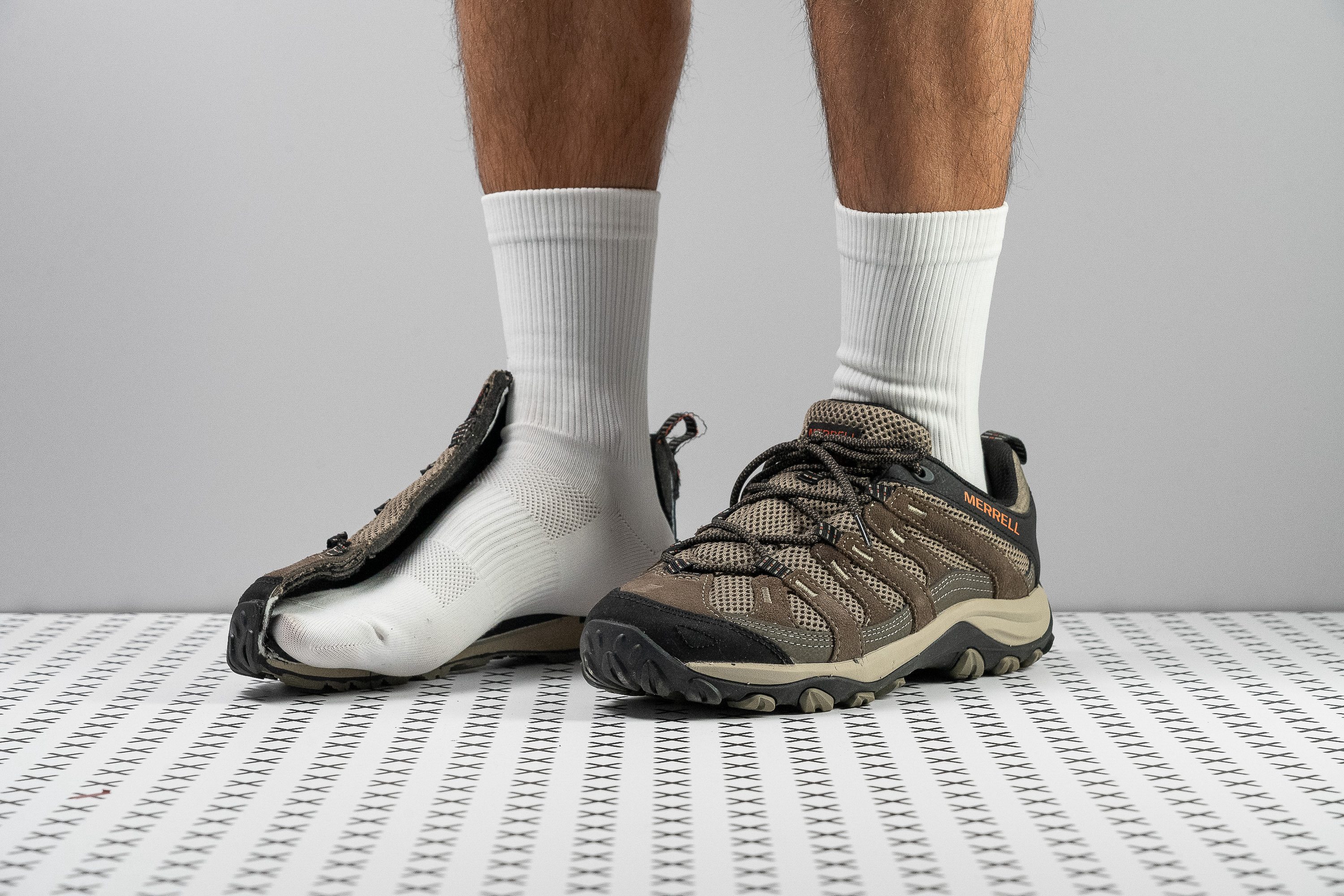Our verdict
Pros
- Reliable grip and traction
- Versatile grip for moderate terrain
- Accommodating toebox
- Smooth and stable ride
- Good for winter hikes
- Budget-friendly
- Sustainably built
Cons
- Too hot for summer hikes
- Not ideal for narrow feet
- Midsole may be too firm for some
Audience verdict
Comparison
The most similar hiking shoes compared
+ + Add a shoe | |||||
|---|---|---|---|---|---|
| Audience score | 79 Good! | 75 Good! | 80 Good! | 89 Great! | |
| Price | $100 | $125 | $100 | $120 | |
| Trail terrain | ModerateTechnical | Moderate | Technical | Technical | |
| Shock absorption | Low | Low | Low | Low | |
| Energy return | Moderate | Moderate | Moderate | Moderate | |
| Weight lab Weight brand | 13.4 oz / 380g 13.4 oz / 380g | 12.9 oz / 367g 12.3 oz / 350g | 13.9 oz / 393g 14 oz / 397g | 15.3 oz / 434g 16.2 oz / 460g | |
| Lightweight | ✓ | ✓ | ✓ | ✗ | |
| Breathability | Warm | Breathable | Warm | Breathable | |
| Use | Day HikingBeginners | Day HikingBeginners | Day HikingBeginners | Day HikingBeginners | |
| Orthotic friendly | ✓ | ✓ | ✓ | ✓ | |
| Drop lab | 14.0 mm | 15.5 mm | 14.1 mm | 11.2 mm | |
| Size | True to size | Slightly small | True to size | True to size | |
| Midsole softness | Firm | Balanced | Firm | Firm | |
| Difference in midsole softness in cold | Small | Normal | Small | Normal | |
| Torsional rigidity | Moderate | Stiff | Moderate | Moderate | |
| Heel counter stiffness | Flexible | Moderate | Moderate | Flexible | |
| Stiffness | Flexible | Moderate | Flexible | Flexible | |
| Outsole hardness | Hard | Average | Very hard | Average | |
| Material | MeshSuede | - | MeshSuede | LeatherMesh | |
| Season | Winter | SummerAll seasons | Winter | SummerAll seasons | |
| Toebox durability | Very good | Good | Very good | - | |
| Heel padding durability | Bad | Decent | Bad | - | |
| Outsole durability | Decent | Decent | Decent | - | |
| Width / fit | Wide | Wide | Medium | Medium | |
| Toebox width | Medium | Medium | Medium | Medium | |
| Lug depth | 4.0 mm | 4.5 mm | 4.3 mm | 4.8 mm | |
| Heel stack lab | 30.6 mm | 34.4 mm | 30.8 mm | 31.7 mm | |
| Forefoot | 16.6 mm | 18.9 mm | 16.7 mm | 20.5 mm | |
| Widths available | Normal | Normal | NormalWide | NormalWide | |
| Technology | - | Ortholite | - | Vibram | |
| Heel tab | Finger loop | Finger loop | Finger loop | Finger loop | |
| Removable insole | ✓ | ✓ | ✓ | ✓ | |
| Ranking | #30 Bottom 14% | #32 Bottom 8% | #28 Bottom 20% | #7 Top 20% | |
| Popularity | #31 Bottom 11% | #12 Top 35% | #17 Top 49% | #1 Top 3% |
Who should buy
We recommend the Merrel Alverstone 2 as a great choice for:
- Hikers looking for a stable and grippy shoe that can tackle difficult, rocky terrains
- Cold-weather adventures looking for a warm hiking shoe that performs consistently no matter how frosty it gets
- Those with broad feet looking for a roomy toebox that provides a comfy and secure fit
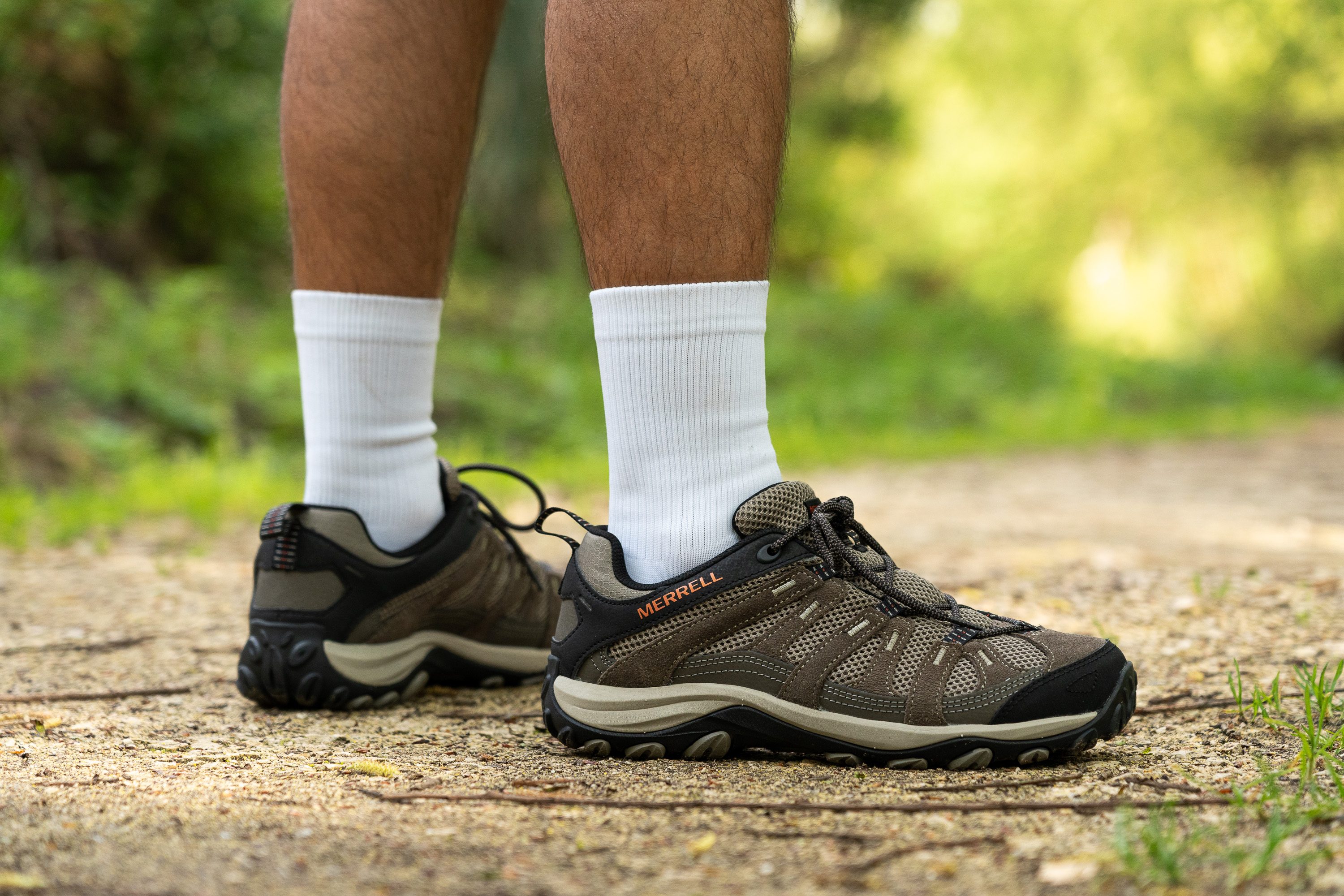
Who should NOT buy
Our smoke test reveals the Alverstone 2 to be quite a stuffy shoe that turns into a sweatbox on hot summer hikes. For those in warmer climates in need of a more breathable shoe, we recommend checking out the KEEN NXIS Speed.
While it is water resistant, the Alverstone 2 isn't meant to be dunked or submerged in water. For a waterproof alternative that can take the occasional shallow riverbed crossing without soaking our feet, we suggest checking out the Gore-Tex lined Merrel Moab 3 GTX instead.
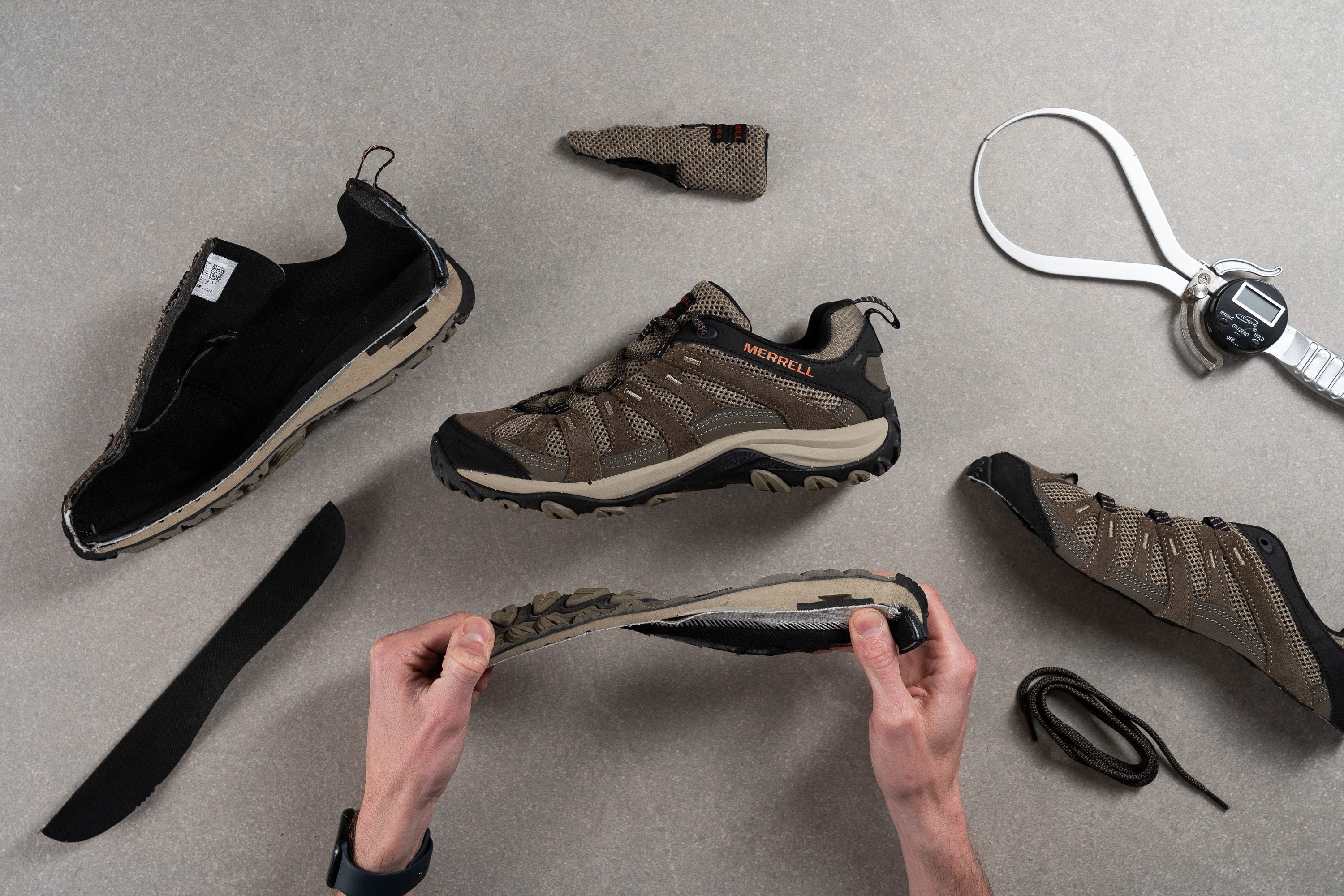
The Alverstone 2's midsole is quite firm, making it a good and stable option for traversing tricky, uneven terrains. However, for hikers who prioritize comfort and want a pillowy shoe that feels like gliding over the trails, we recommend the Hoka Skyline-Float X as a comfier alternative.
Hikers with narrow feet may find the Alverstone 2's toebox to be a little too spacious and feel themselves shifting within the shoe, especially during tricky descents. For a more snug option, we recommend looking into the Merrel Moab 3 instead.
Cushioning
Shock absorption
Just like the Merrell Accentor 3, the Alverstone 2 features an Air Cushion unit in the heel for added impact protection. However, it's not the Nike Air Max unit you might be thinking of; it's just a cavity with softer foam on top of it which has a moderate effect on the shoe's shock absorption.
Measuring the latter at 94 SA, we found that the Alverstone 2 offers just enough comfort for light-to-moderate day hikes but it's not the most well-cushioned experience in a hiking shoe.

| Alverstone 2 | 94 SA |
| Average | 104 SA |
Energy return
The midsole rebound is barely noticeable in this Merrell shoe. With a low energy return of 47%, its ride feels rather dull and muted but it offers a stable base in return.
| Alverstone 2 | 47.0% |
| Average | 50.2% |
Heel stack
Using our caliper, we measured the Alverstone 2's stack to be 30.6 mm thick at the heel. This is about as high as our current lab average and gives us a good amount of foam and rubber underfoot to effectively dampen our landings.
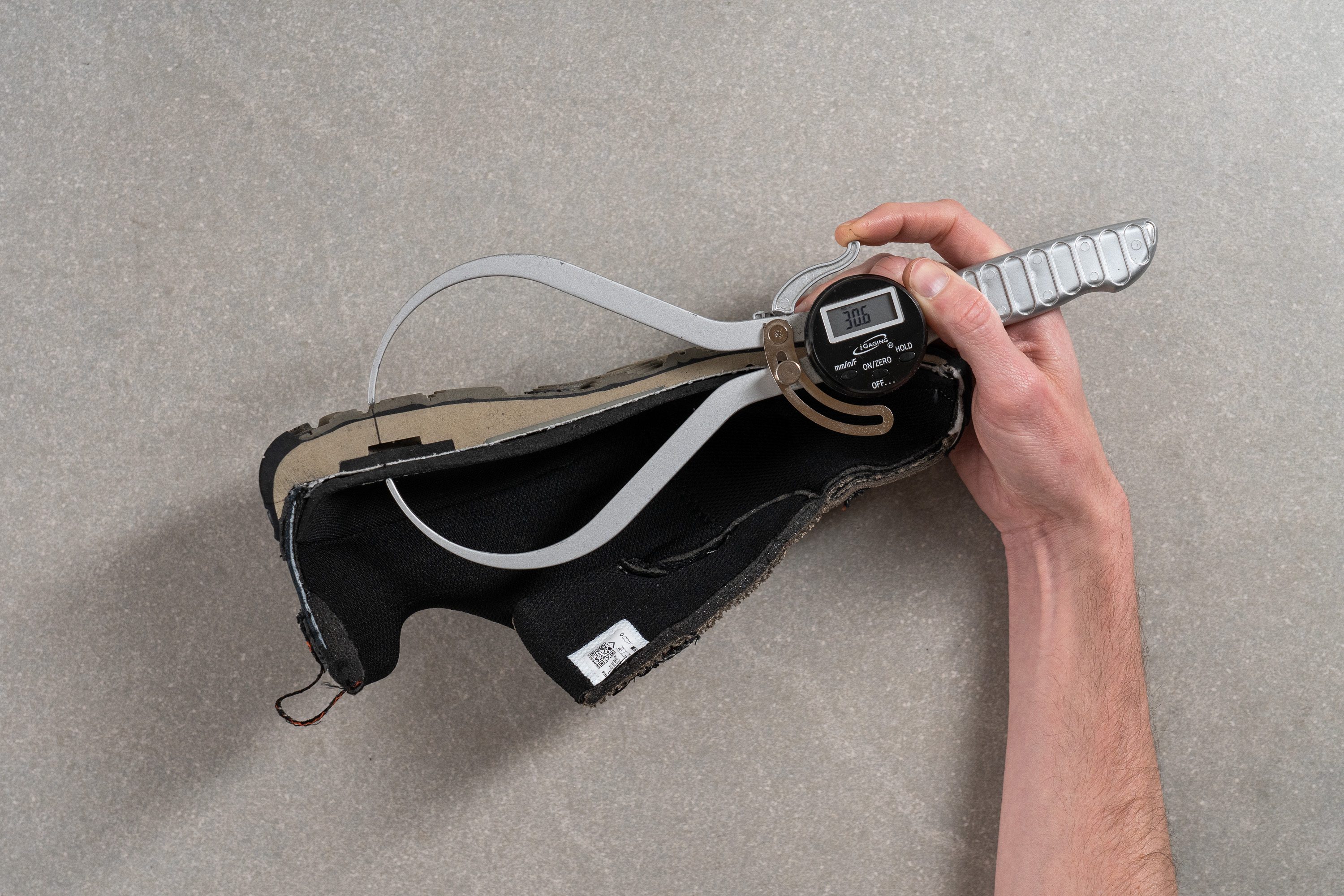
The heel stack also features a little pocket of softer foam right under our heel. This further adds to our sense of perceived cushioning as our foot sinks into the midsole more in that part of the shoe.
| Alverstone 2 | 30.6 mm |
| Average | 32.8 mm |
Forefoot stack
At only 16.6 mm thick according to our caliper measurements, the Alverstone 2's stack is lower than average at the forefoot. While this part of the shoe doesn't feel nearly as cushioned, it does feel quite grounded and stable.
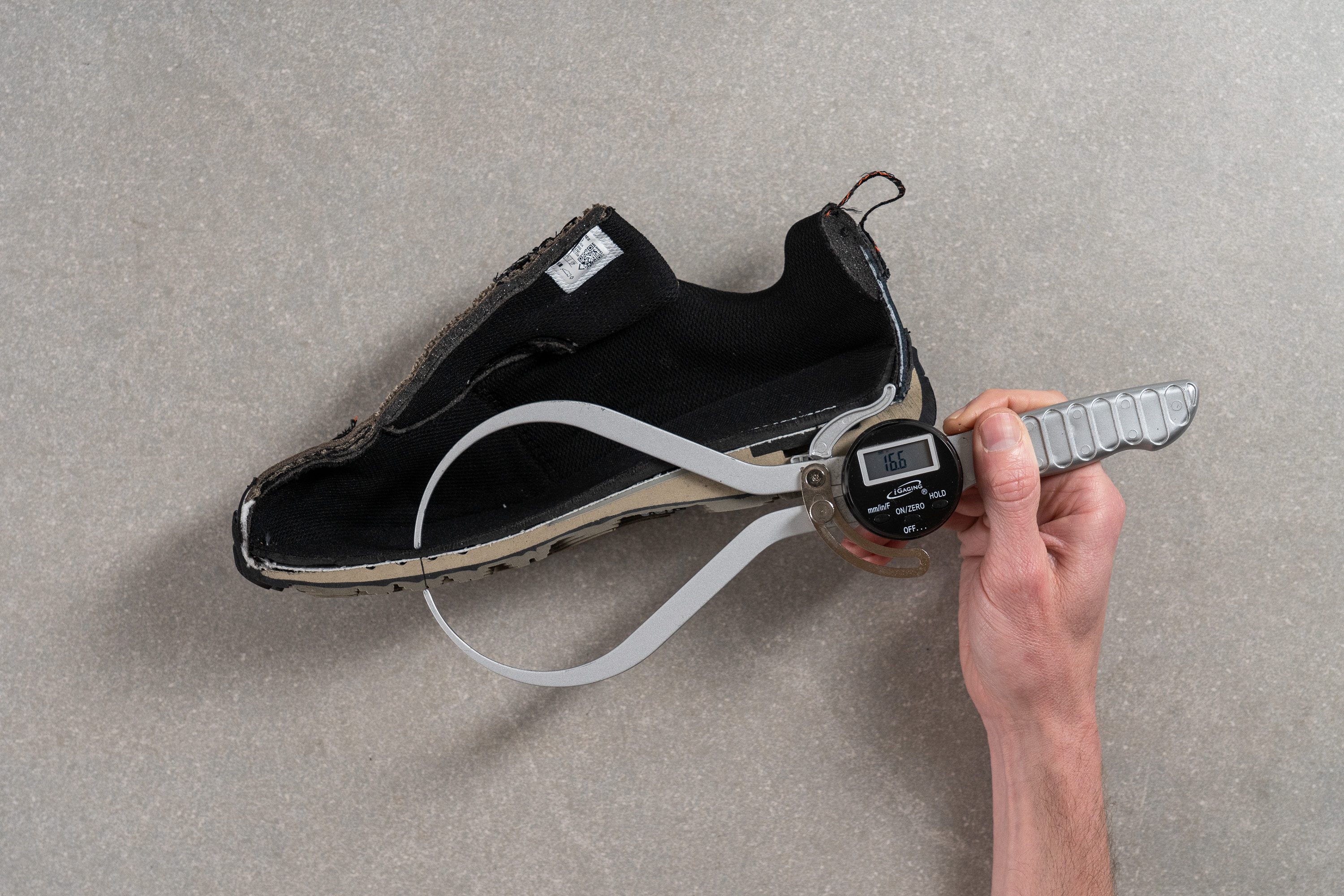
| Alverstone 2 | 16.6 mm |
| Average | 22.0 mm |
Drop
The difference in our stack measurements leaves us with a rather steep offset of 14 mm which means that our heel is quite elevated in comparison to our forefoot. In practical terms, this presents us with a good mix of well-dampened rearfoot landings and intuitive toe-offs while testing this shoe.

| Alverstone 2 | 14.0 mm |
| Average | 10.7 mm |
Midsole softness
The Alverstone 2's midsole foam is significantly firmer than average, giving us a durometer reading of 35.4 HA.

As such, the midsole isn't just protective but quite stable too as it doesn't feel too squishy underfoot. This means that we were able to confidently traverse rocky and uneven terrains while testing this shoe, even when laden with a heavy pack.
| Alverstone 2 | 35.4 HA |
| Average | 27.0 HA |
Secondary foam softness
That little piece of foam under the heel we mentioned earlier is a little softer than the main slab, giving us a durometer reading of 27.3 HA. Its placement right under our heel means that our foot really sinks into the midsole in that part of the shoe as it compresses under our weight.

| Alverstone 2 | 27.3 HA |
| Average | 28.8 HA |
Size and fit
Size
Merrell Alverstone 2 fits true to size (37 votes).
Internal length
| Alverstone 2 | 268.6 mm |
| Average | 268.7 mm |
Width / Fit
Like most Merrell hiking shoes we've tested, the Alverstone 2 treated us to a rather accommodating fit.
Once the shoe's mold was jellified, we used a caliper to measure its width at its widest point. The tool showed an above-average reading of 97.2 mm.

Thus, we believe that the Alverstone 2 can comfortably accommodate hikers with broad feet even in a medium width. But if you want to play it safe, the shoe is also available in wide.
| Alverstone 2 | 97.2 mm |
| Average | 94.1 mm |
Toebox width
Another reason why some people may prefer the wide version is the shoe's tangible taper angle. It gets notably narrower towards the tip shrinking to below-average 71.6 mm at the big toe mark.

| Alverstone 2 | 71.6 mm |
| Average | 72.5 mm |
Toebox height
The vertical space doesn't add much extra space either showing just an average reading of 28.1 mm. But for a medium-width foot, the Alverstone 2 heel right at home.

| Alverstone 2 | 28.1 mm |
| Average | 28.0 mm |
Traction / Grip
Lug depth
Its 4.0 mm lug depth makes the Alverstone 2 perfectly versatile for mixed terrain with rocks, roots, grass, light mud, and everything in between.

| Alverstone 2 | 4.0 mm |
| Average | 4.0 mm |
Outsole design
The smooth nature and wide shape of this Merrell shoe's tread also make it suitable for hard-packed terrain, park trails, forest boardwalks, and even concrete urban surfaces.
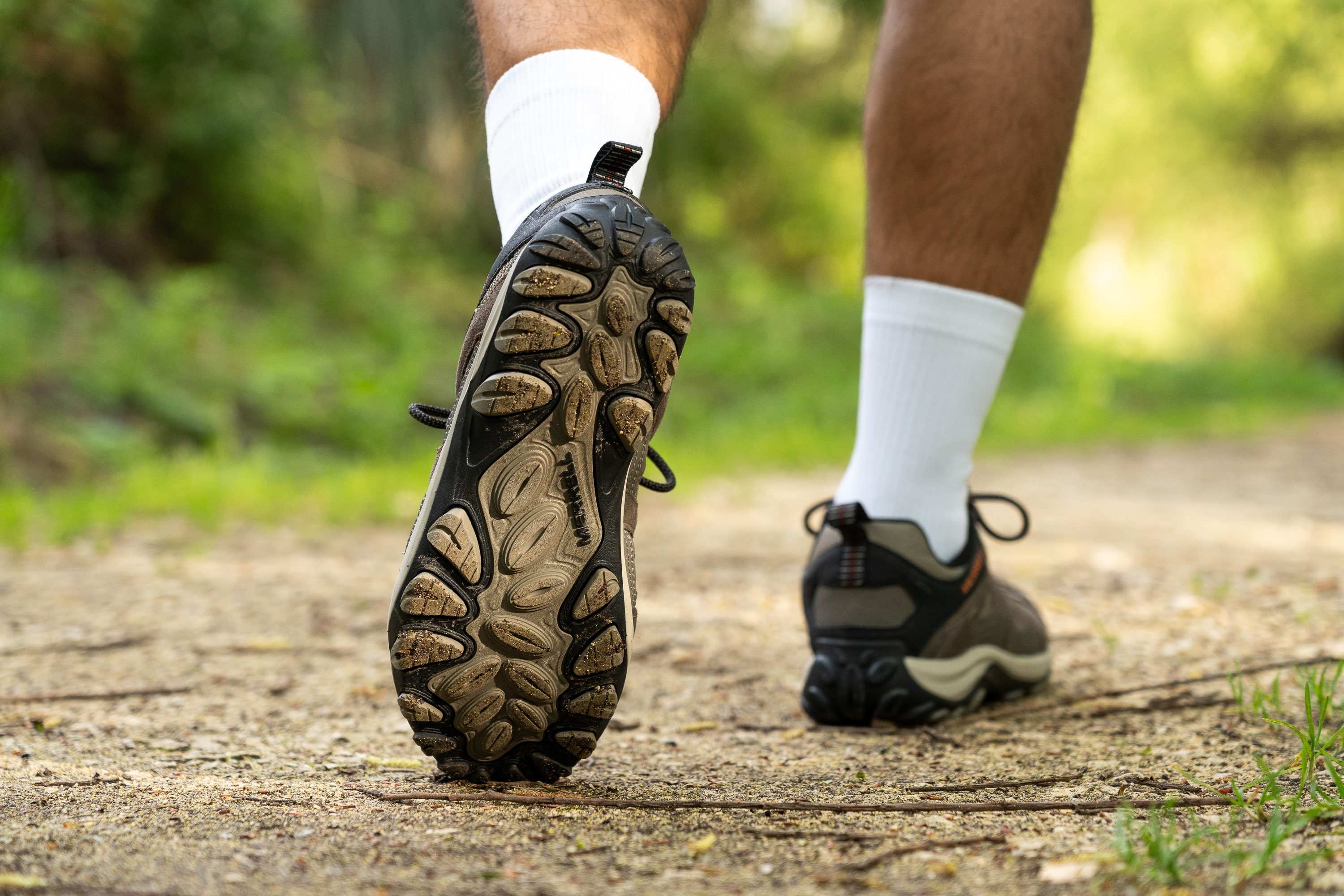
Flexibility / Stiffness
Despite the shank we mentioned in the previous section, the Alverstone 2 is significantly more flexible than the average hiking shoe.
Our shoe flexing tester showed that only 13.1N of force is needed to bend this Merrell shoe to 30 degrees. This factors into the shoe's rather comfy and natural feeling ride as it doesn't put up much resistance to the flexion of our foot.
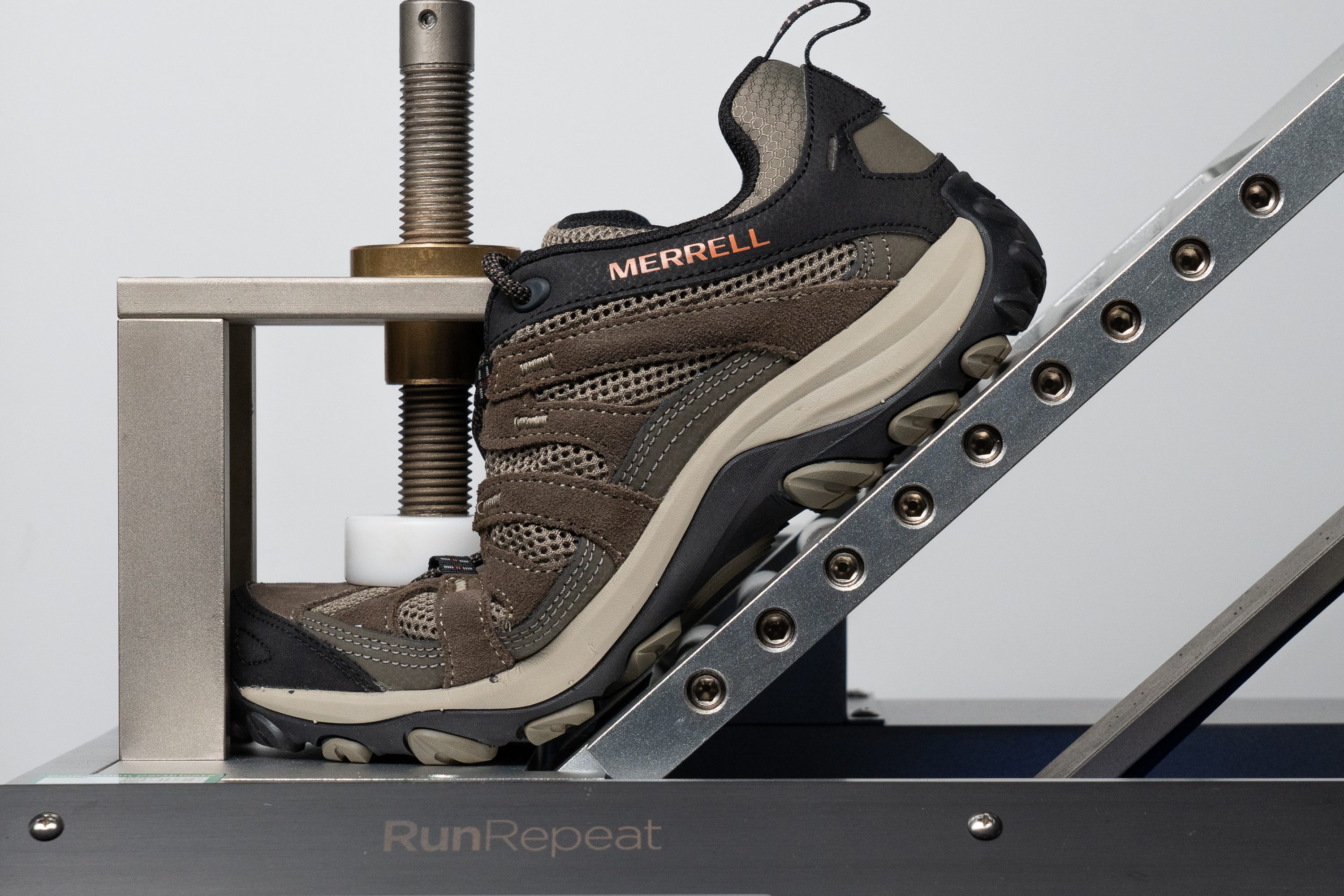
| Alverstone 2 | 13.1N |
| Average | 18.3N |
Weight
At 13.4 oz (380g) according to our scale, the Alverstone 2 is about as heavy as the average hiking shoe.
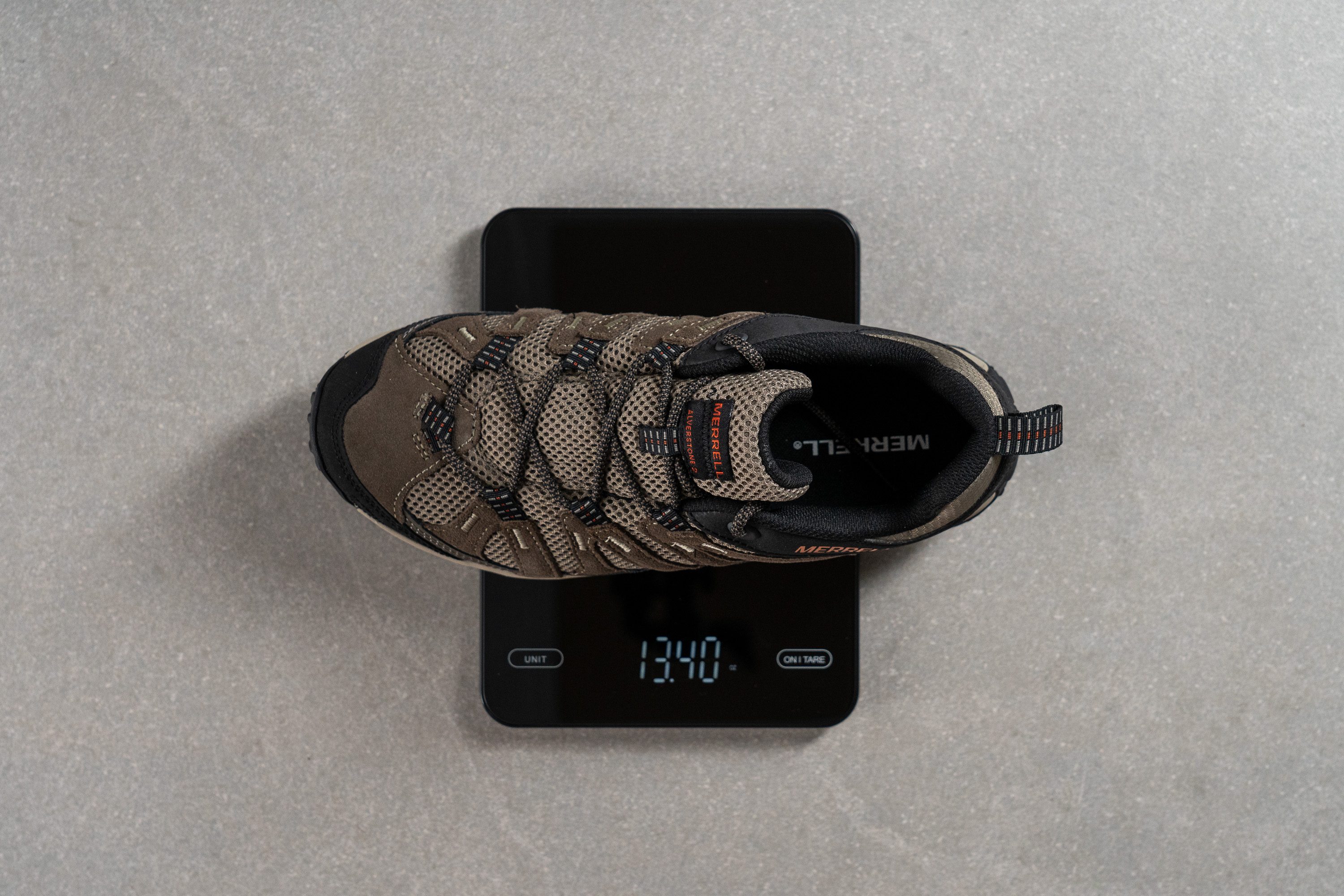
| Alverstone 2 | 13.4 oz (380g) |
| Average | 13.4 oz (380g) |
Breathability
We put the Alverstone 2 through our state-of-the-art smoke test to see how breathable it is. Despite featuring so much mesh in its upper construction, the shoe turns out to be very well-insulated, with only little wisps of smoke managing to escape around the tongue. This leads us to give it the lowest breathability score of 1 out of 5. As such, the Alverstone 2 will feel far too warm come the summer months and is much better suited to colder hikes.
This is further confirmed when inspecting a cross-section of the shoe over a backlight. While the mesh seems rather porous and airy, the light isn't able to shine through any part of the shoe.
The culprit of this substandard airflow, apart from the heavy use of suede in the upper, is the solid internal lining material that prevents the perforations from going all the way through the shoe. While this is meant to help with the shoe's water resistance in the event of rain or a light splashing, it also means that the shoe won't drain and will take some time to dry if soaked.
Even when looking at the upper under our microscope, we could be led to believe by the many little gaps that the Alverstone 2 is a breathable shoe. However, the proof is in the pudding whenever we take them out on a warm day and the shoe becomes a sweat bucket by the time we're back.
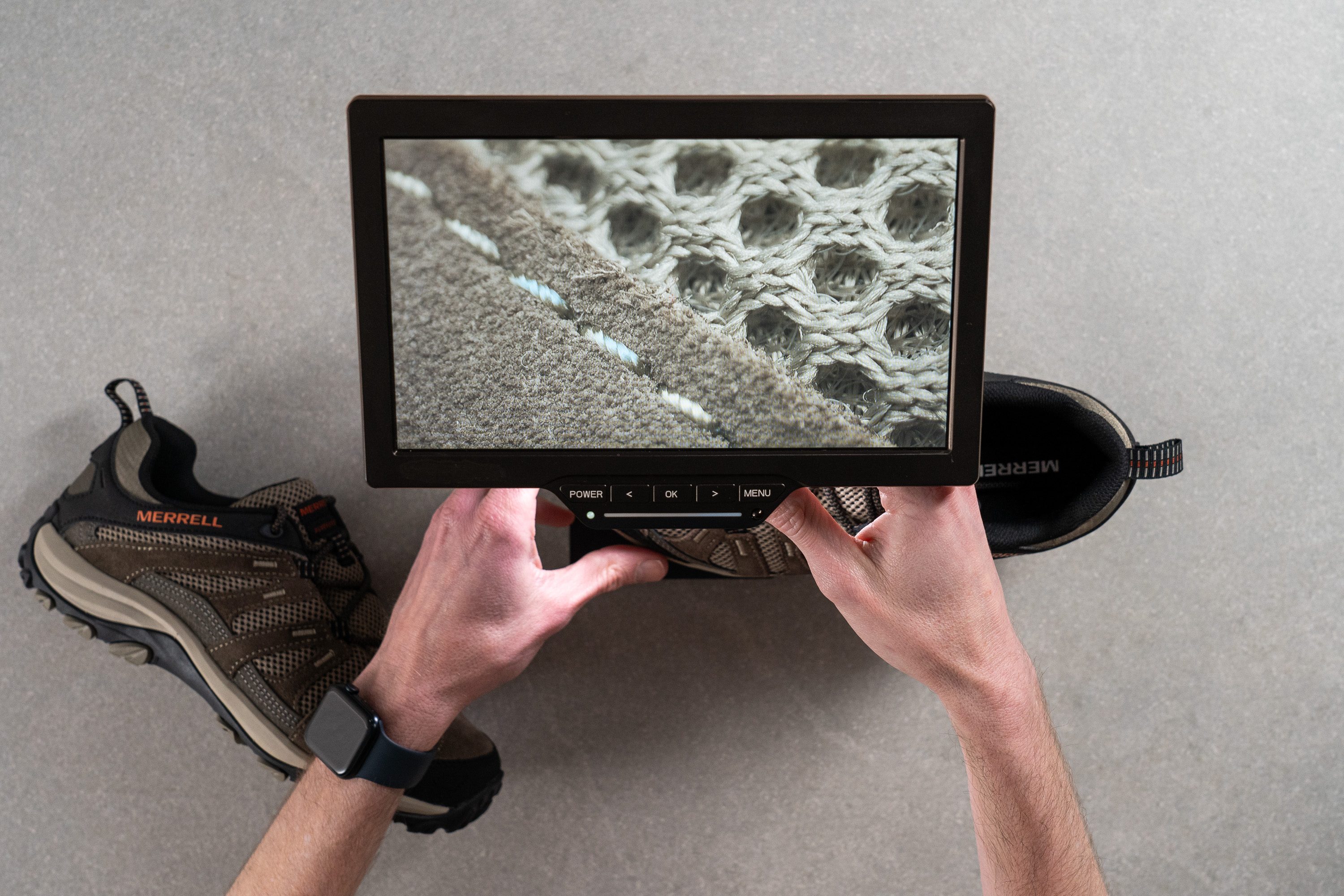
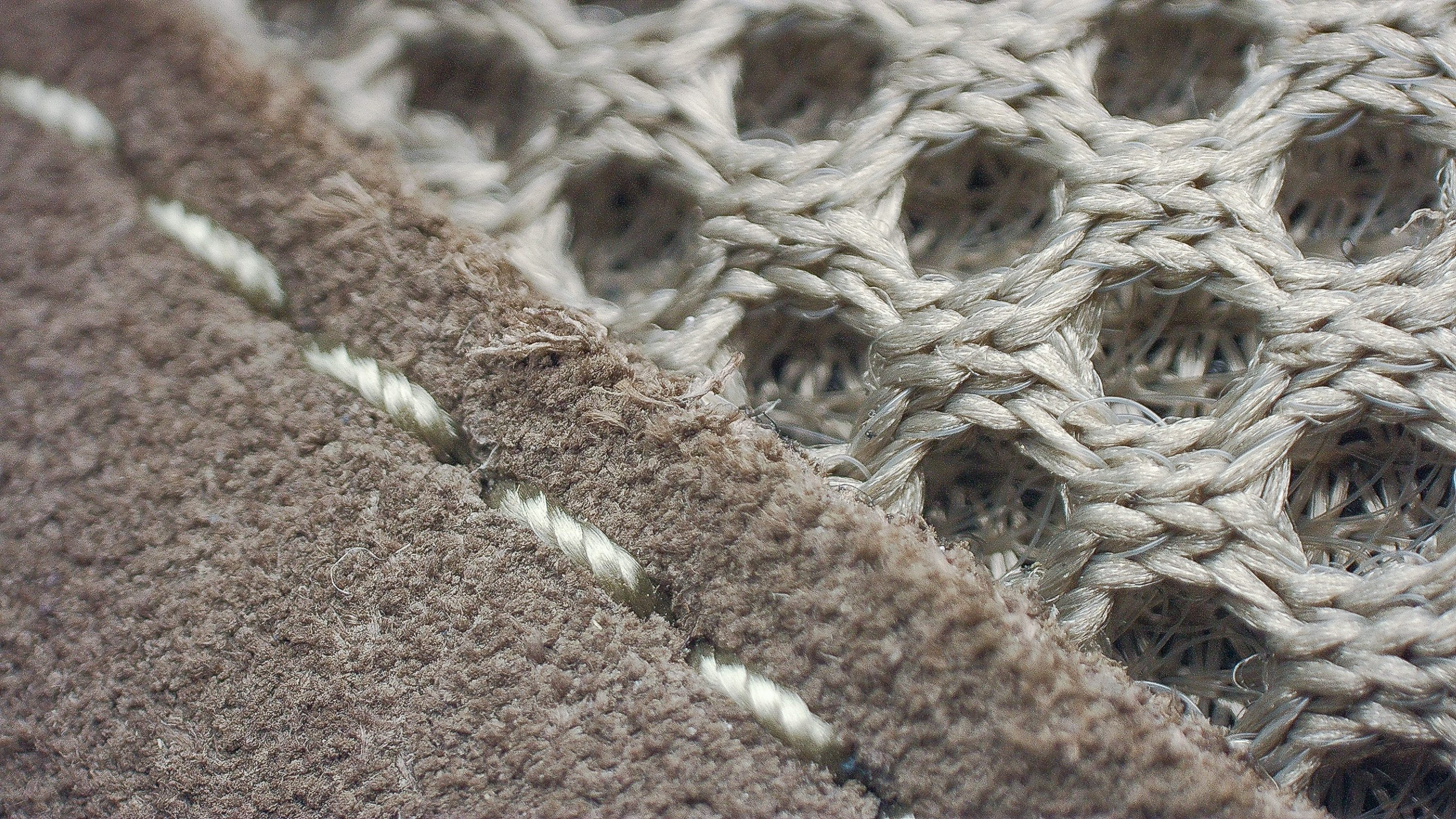
| Alverstone 2 | 1 |
| Average | 2.4 |
Stability
Lateral stability test
With its firm midsole on a well-grounded stack, the Alverstone 2 feels rather stable underfoot. This stable feeling is further bolstered by the shank that's embedded within the foam right under the arch. This not only provides us with strong arch support during our test hikes but helps distribute our weight throughout our stride.
Torsional rigidity
The dense midsole and the aforementioned shank lend the shoe a level of torsional rigidity that we scored 3 out of 5 on our subjective scale. This middle-of-the-road score implies a good balance of comfort and stability as the shoe doesn't resist the natural movements of our foot too much while still leaving us with a relatively level landing platform.
| Alverstone 2 | 3 |
| Average | 3.7 |
Heel counter stiffness
The heel counter is also moderately stiff, earning another 3 out of 5 in our manual assessment. This means that the shoe feels well-structured and supportive at the rearfoot without being too constrictive on our tendons.
| Alverstone 2 | 3 |
| Average | 3.7 |
Midsole width - forefoot
We measured the midsole to be 109.3 mm wide at the forefoot which is on par with our current lab average. This is more than enough of a platform for us to push off with confidence without feeling too chunky or blocky.

| Alverstone 2 | 109.3 mm |
| Average | 111.3 mm |
Midsole width - heel
Back at the heel, the midsole is significantly narrower than our current lab average at only 81.1 mm thick according to our caliper. This is good for rocky trails as it means that we're able to fit our foot into tighter spaces without it getting caught or snagged as we pull away. However, for hikers more accustomed to having a broader landing surface we recommend checking out the Adidas Terrex AX4 instead.
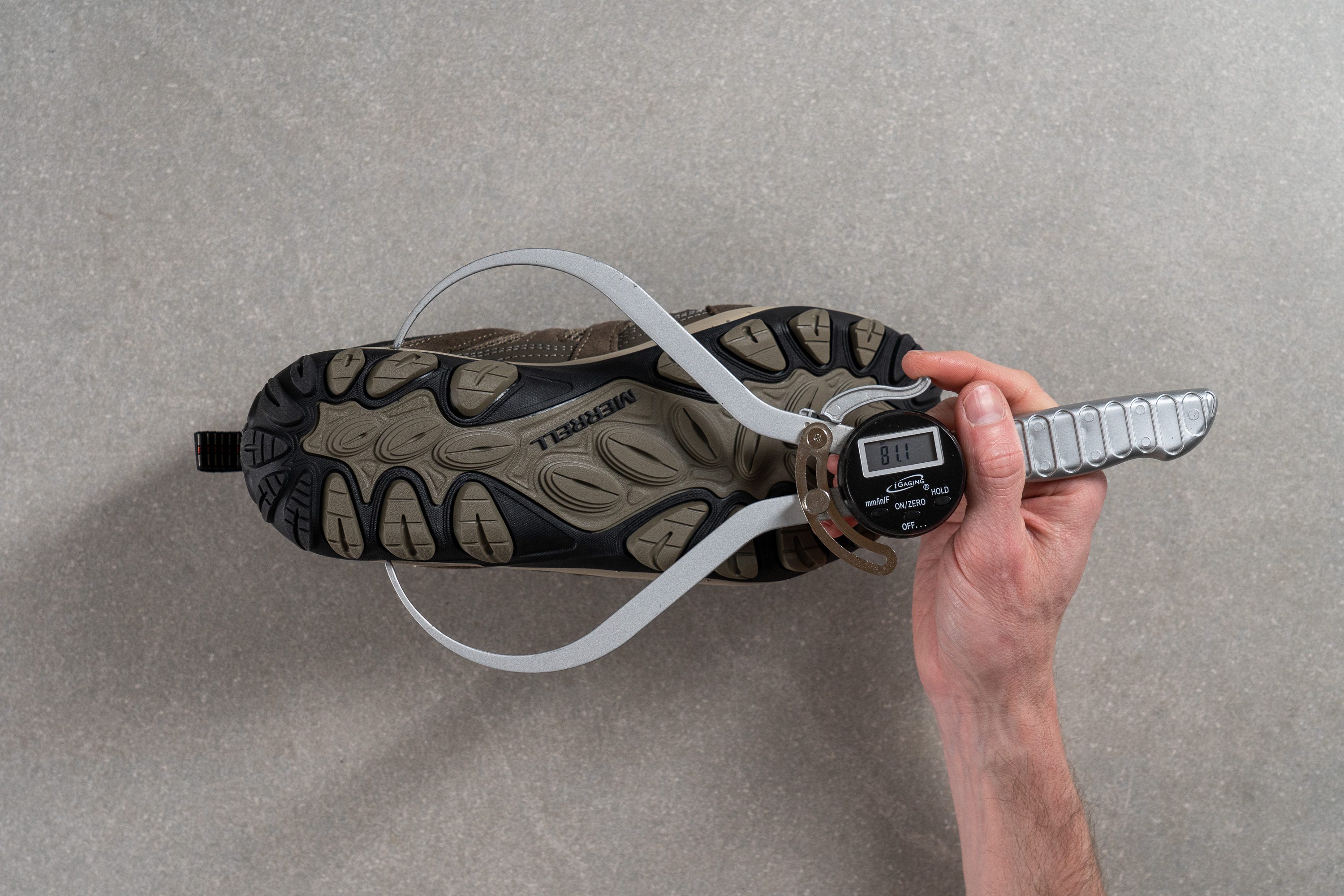
| Alverstone 2 | 81.1 mm |
| Average | 87.9 mm |
Durability
Toebox durability
For what it lacks in breathability, the Alverstone 2's toebox more than makes up for with strength. We fired up our Dremel to 5K RPM and set it against the suede portion beyond the protective toe bumper with 3.2N of force.
After twelve seconds, we were impressed, though not entirely surprised, to find that our tool had merely grazed the suede and only left a minor scuff in its wake. This earns the Alverstone 2 a perfect 5 out of 5 for toebox durability,

Compare that to the utter destruction we wrought upon the Hoka Anacapa Mid GTX in this same assessment.
| Alverstone 2 | 5 |
| Average | 3.7 |
Heel padding durability
Next, we turn our attention to another part of the shoe highly susceptible to wear and tear, the heel collar.
After a quick four-second bout with our Dremel, the Alverstone 2 was left with a rather large hole in its lining and had some of its padding compromised. This leads us to give it a below-average heel padding durability score of 2 out of 5. While this means we don't recommend going sockless while hiking in this shoe, it shouldn't be an issue when it comes to normal use.

| Alverstone 2 | 2 |
| Average | 3 |
Outsole hardness
Pressing our durometer against the outsole rubber yields a harder-than-average reading of 91.6 HC. As this is the first part of the shoe to make contact with the ground, it initially makes our landings feel rather firm before the midsole cushioning kicks in. This not only feels protective when we're traversing harder terrains but also bites into softer surfaces quite nicely.
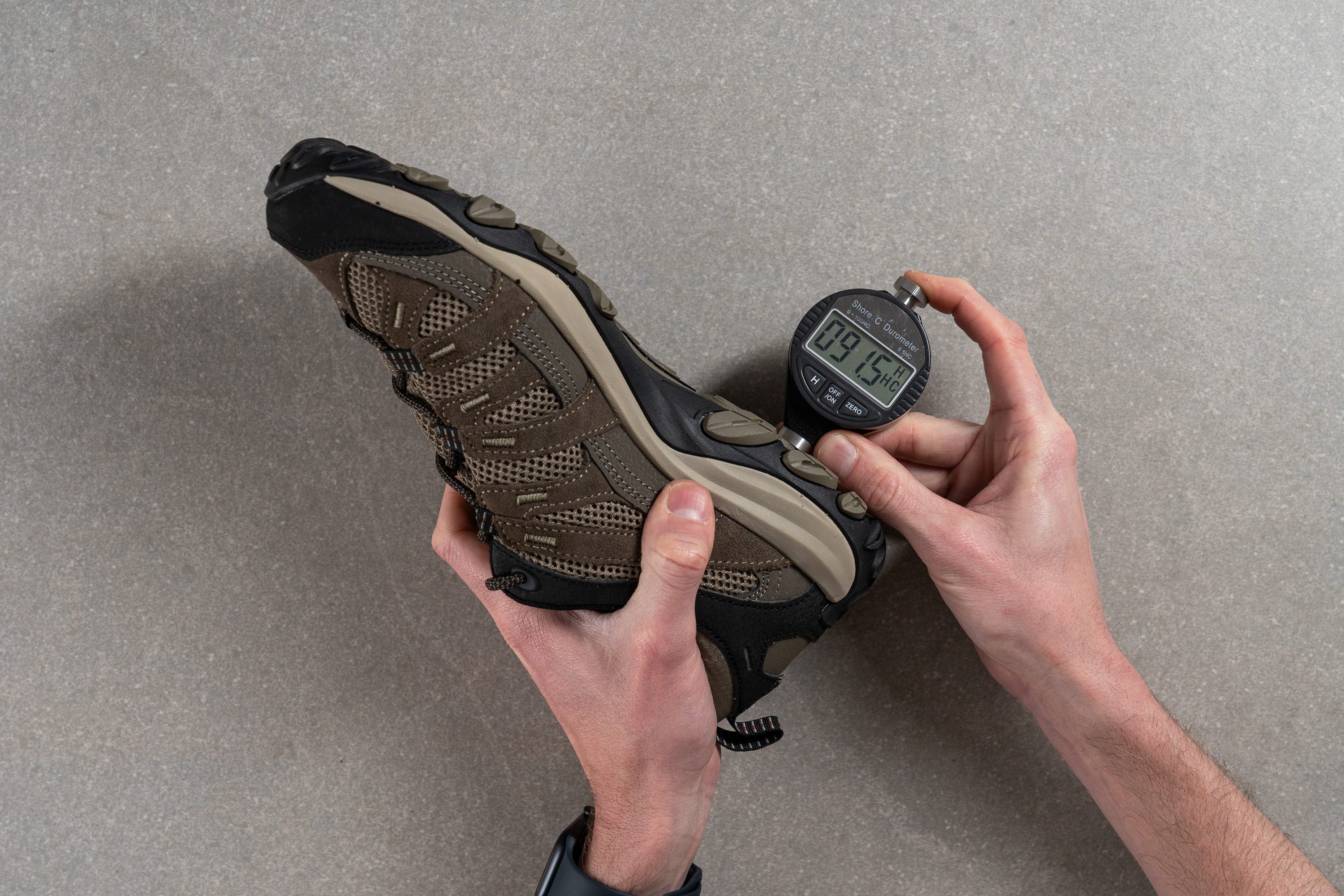
| Alverstone 2 | 91.6 HC |
| Average | 85.1 HC |
Outsole durability
This time spinning at 10K RPM, we pressed our Dremel against the Alverstone 2's outsole for twenty-two seconds of grinding.
While our findings in the lab generally show that a harder outsole is more durable, the Alverstone 2 reminds us that there are exceptions to any rule. With 1.1 mm of rubber lost according to our tire tread gauge, the Alverstone 2's outsole performs about the same as the average hiking shoe. This isn't bad per se as the shoe should still last the expected 800 miles before any major deterioration.
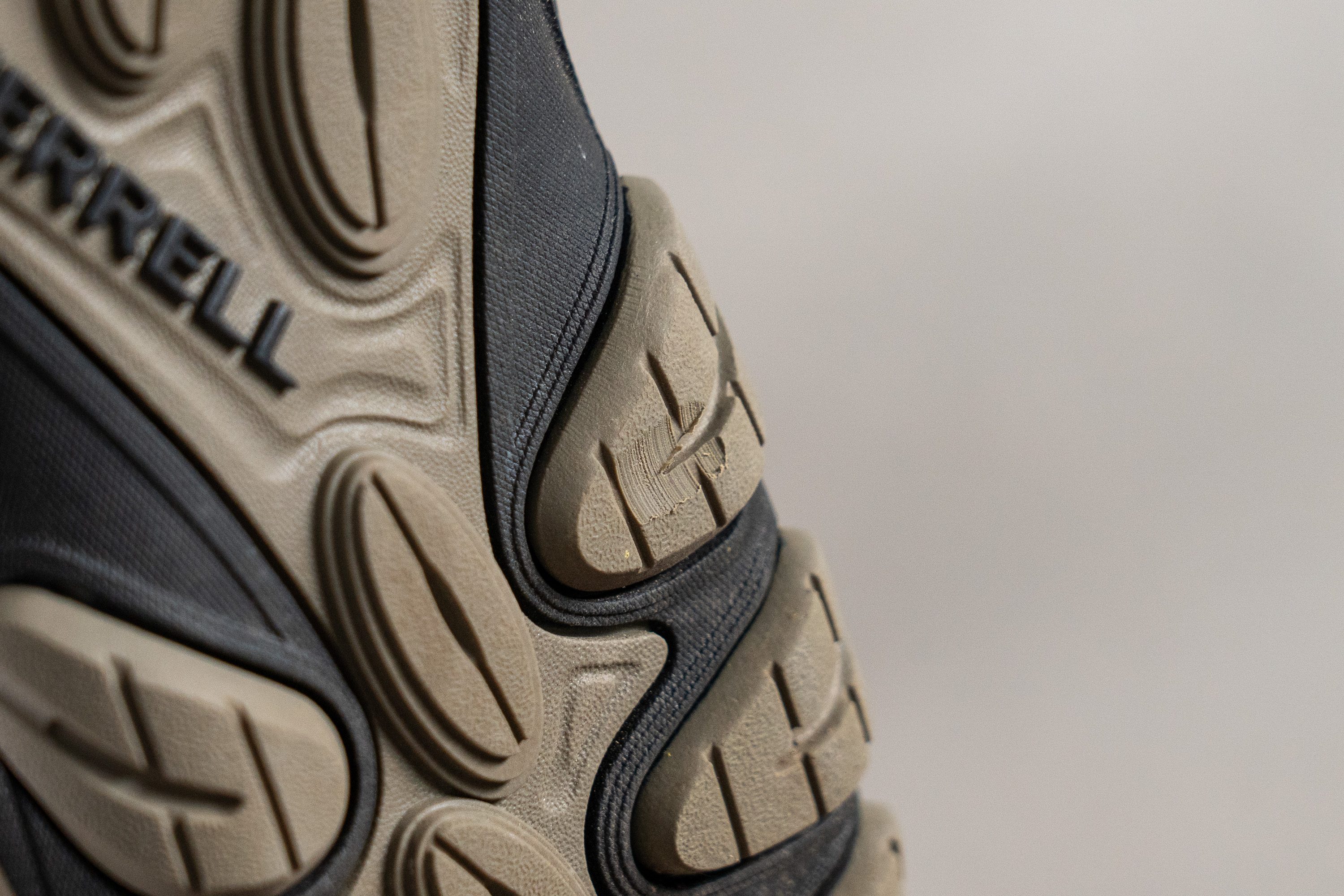
| Alverstone 2 | 1.1 mm |
| Average | 1.0 mm |
Outsole thickness
There's quite a healthy amount of protective rubber underfoot, with the outsole measuring 3.8 mm thick. This is thicker than average and, including the lugs below, gives us a good amount of material to wear through before the shoe is out of commission.

| Alverstone 2 | 3.8 mm |
| Average | 2.5 mm |
Misc
Insole thickness
At 3.7 mm thick according to our caliper measurements, the Alverstone 2's insole isn't nearly as thick as our current lab average. This offers us a somewhat soft footbed within the shoe that, like the midsole, doesn't feel overly cushy.
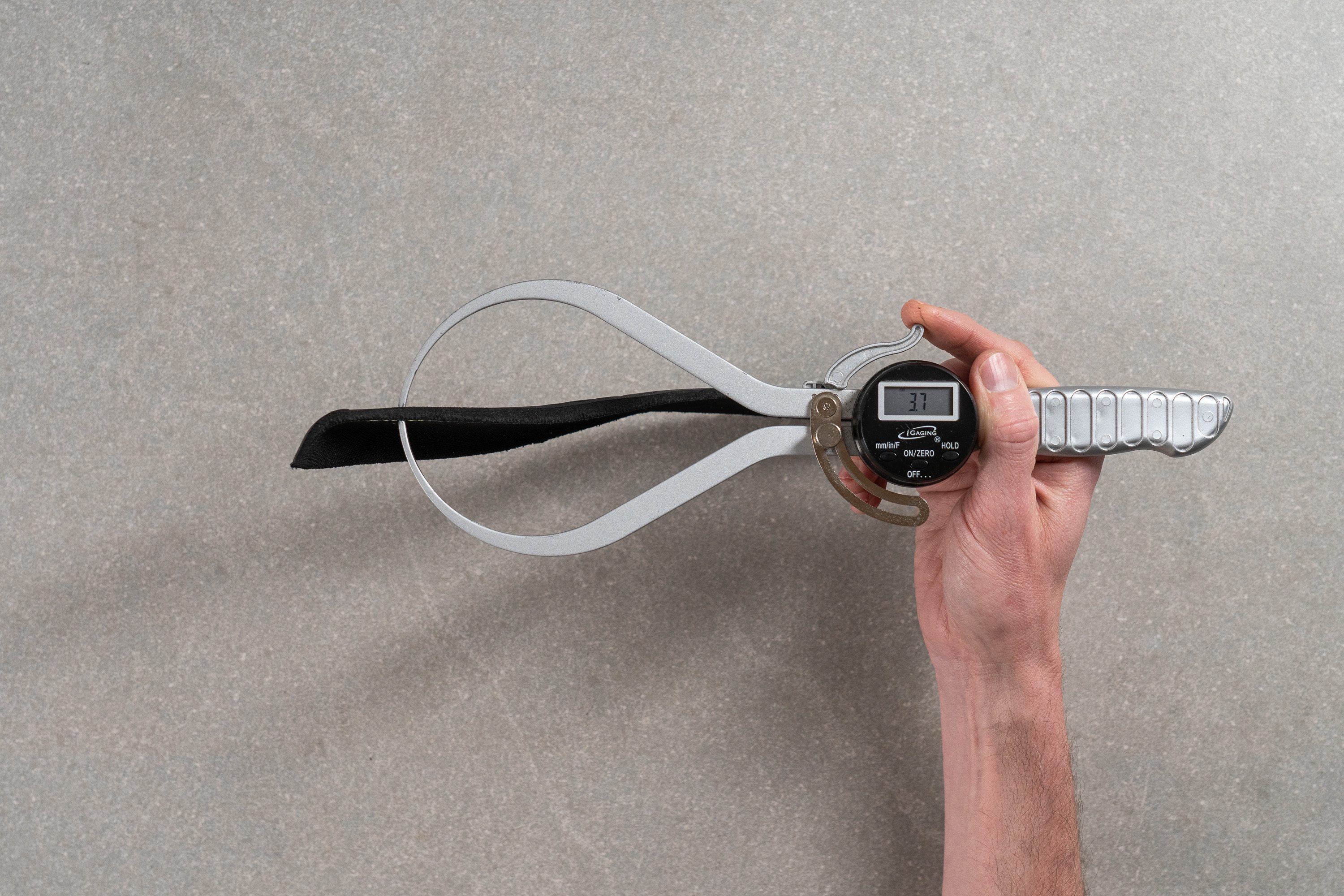
| Alverstone 2 | 3.7 mm |
| Average | 5.3 mm |
Removable insole
The Alverstone 2's insole isn't glued in so it can easily be replaced with an aftermarket alternative or a custom orthotic if needed.
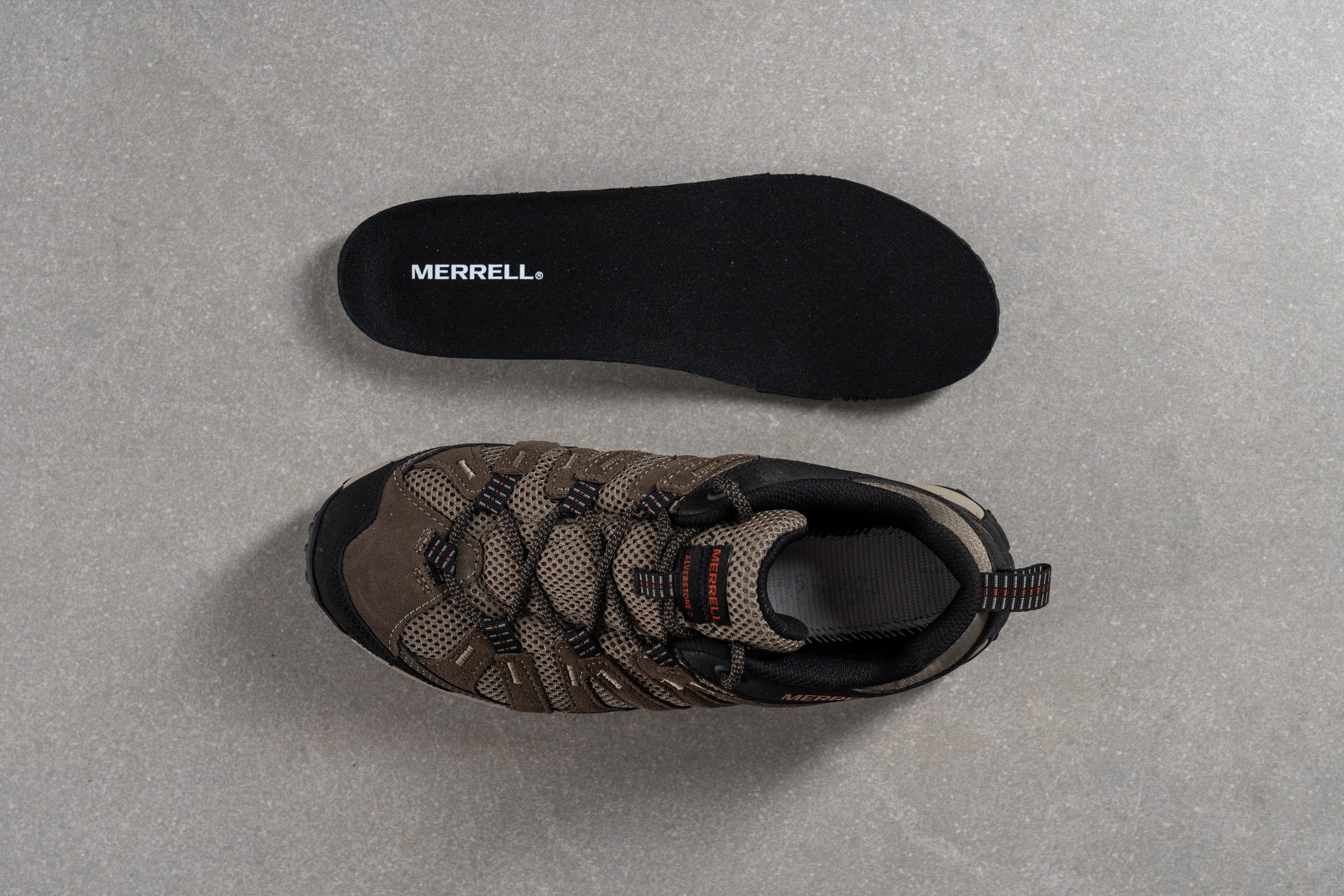
| Alverstone 2 | Yes |
Midsole softness in cold (%)
We placed the Alverstone 2 in our freezer for twenty minutes to see how cold conditions affect the midsole. After twenty minutes, we pressed our durometer against the foam once more and found that it only became 8.8% firmer. This is a much more consistent performance than the average hiking shoe and means that the Alverstone 2 won't feel too different underfoot no matter how frosty it gets.
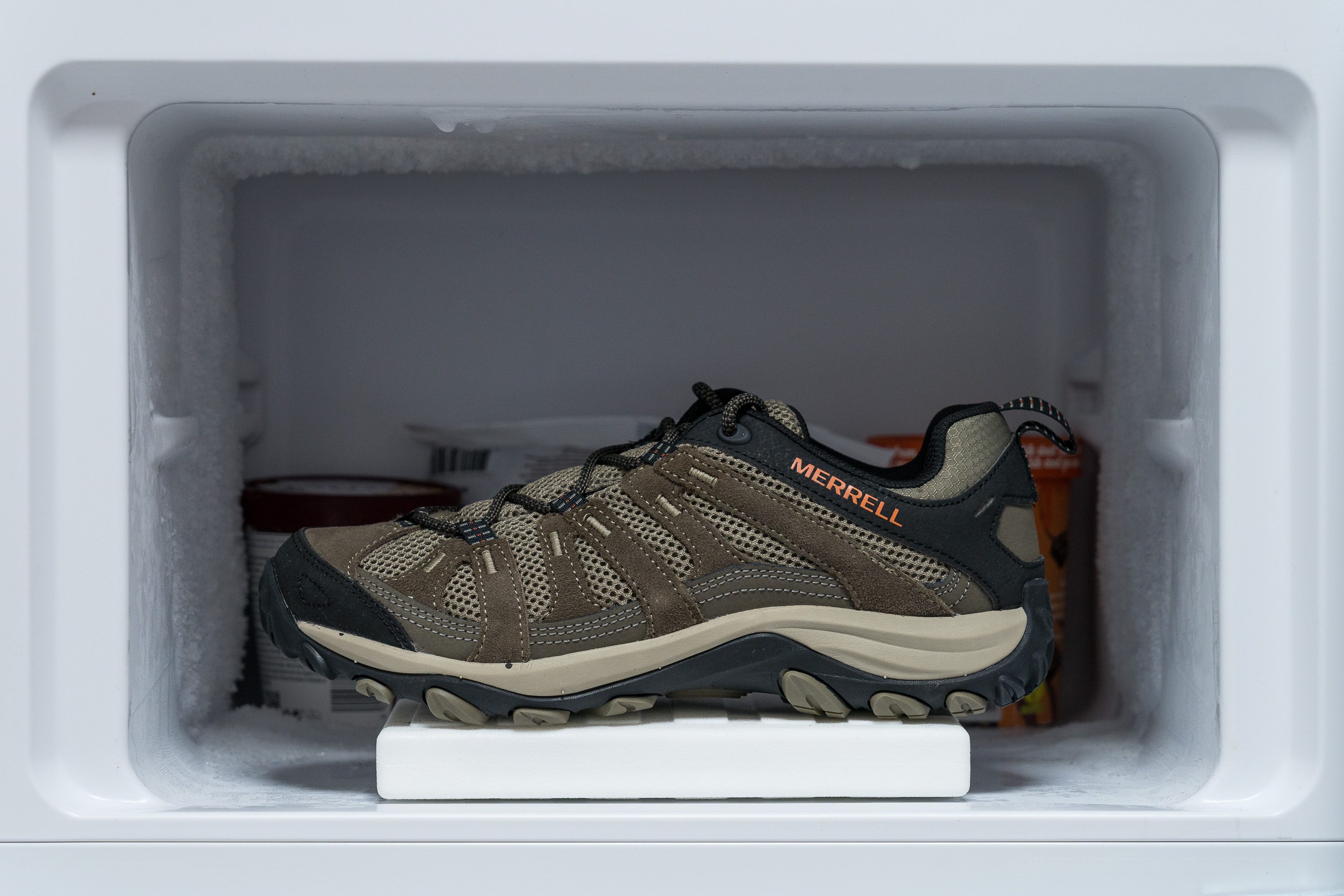
| Alverstone 2 | 9% |
| Average | 19% |
Reflective elements
The Alverstone 2 doesn't feature any reflective elements whatsoever, so we don't recommend hiking along dimly lit roads at night without any additional high-vis gear.
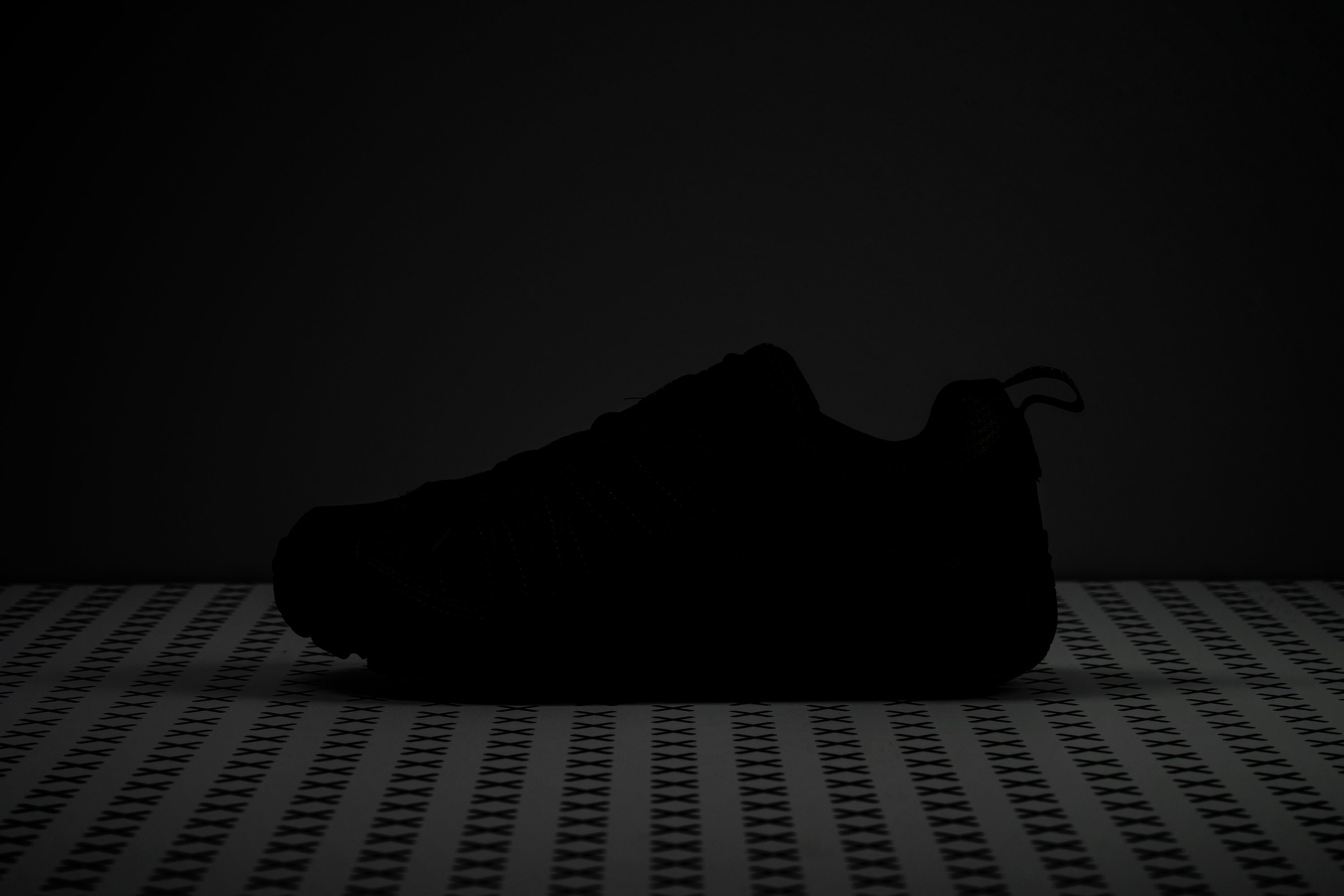
| Alverstone 2 | No |
Tongue padding
The tongue is 9 mm thick according to our caliper measurements. This is about as thick as average for a hiking shoe which leaves us with a nice and comfortable buffer between our instep and the laces.
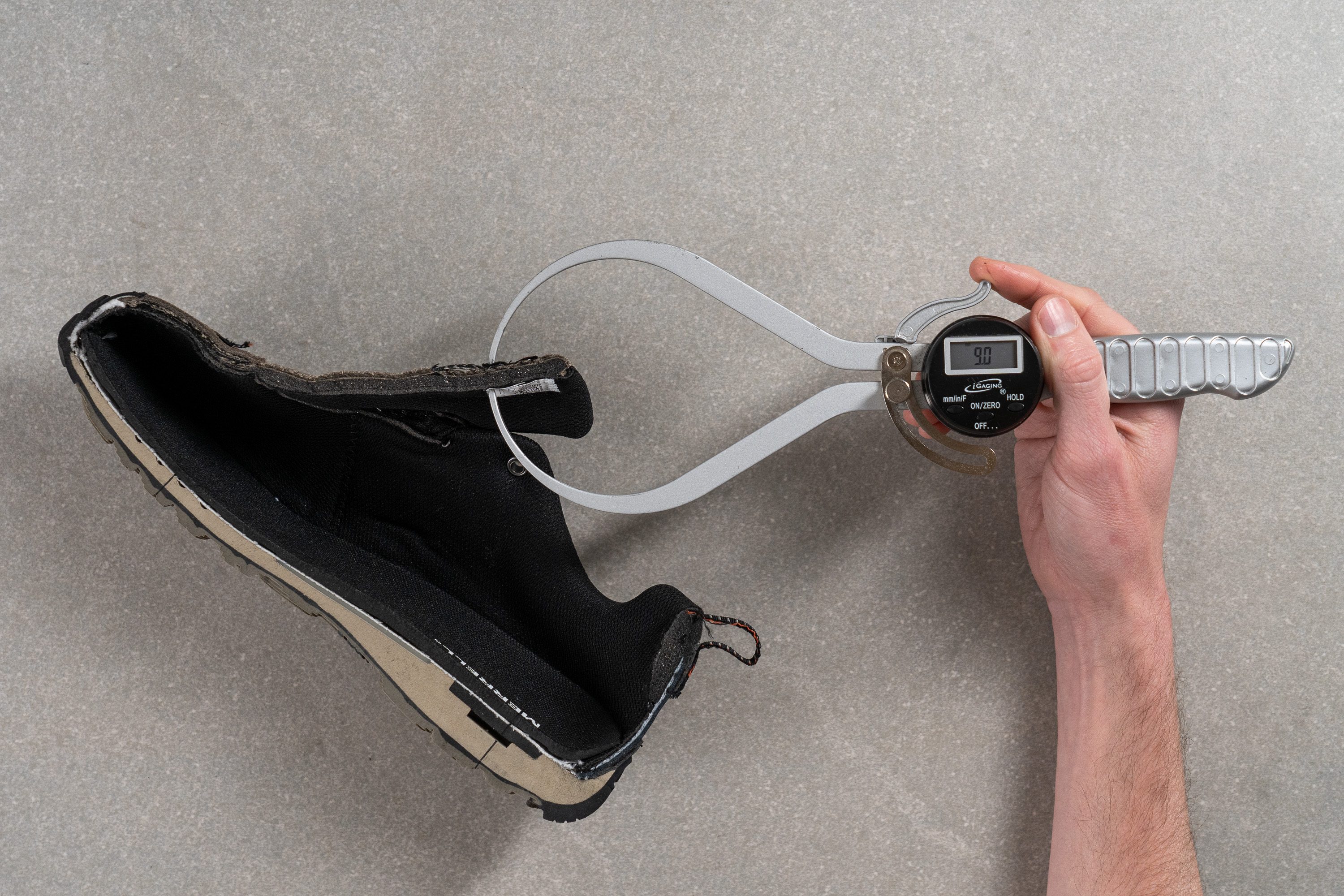
| Alverstone 2 | 9.0 mm |
| Average | 10.2 mm |
Tongue: gusset type
The Alverstone 2's tongue is fully gusseted on both sides which not only keeps it secure in place but also prevents any bits of grit or debris from entering the shoe.
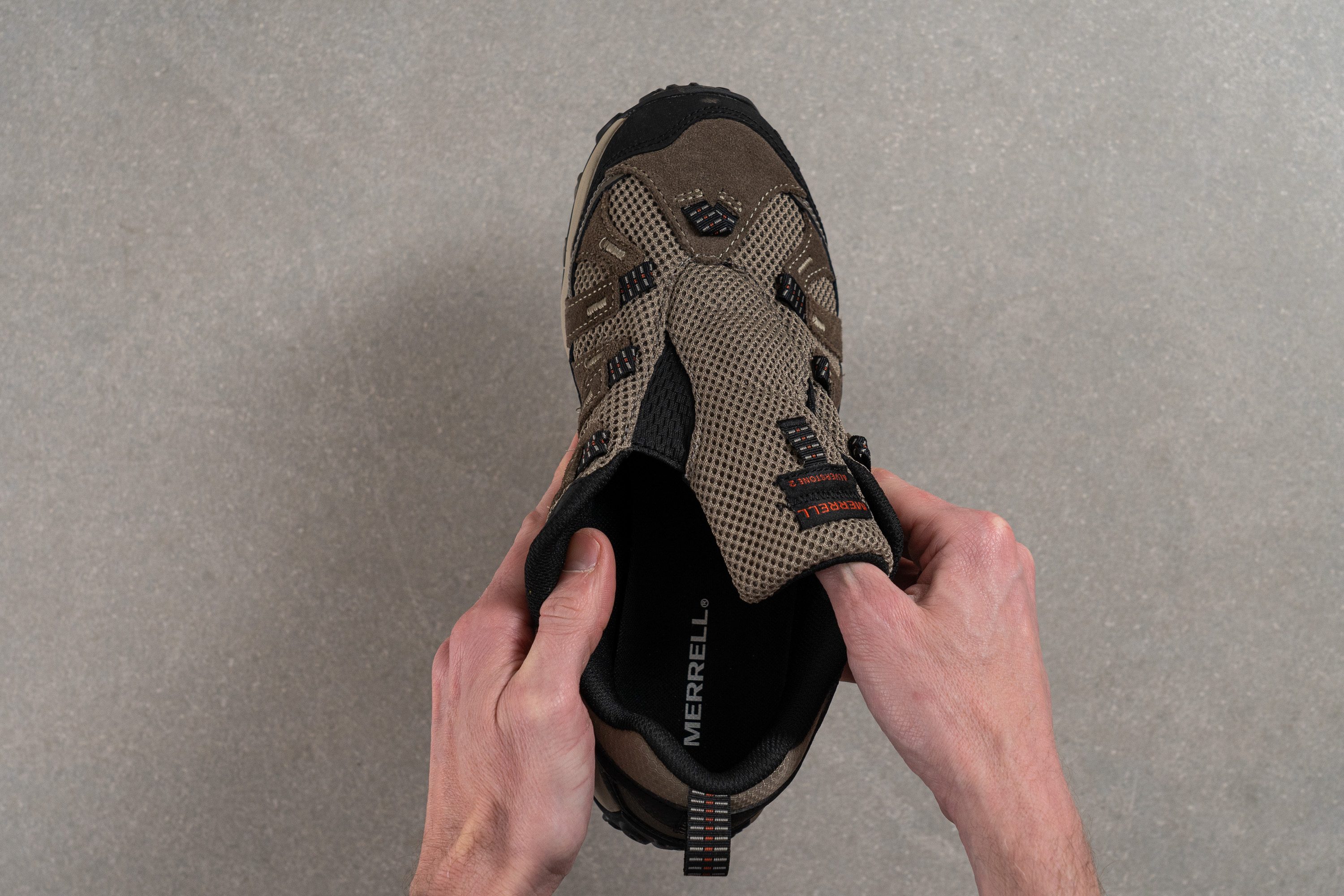
| Alverstone 2 | Both sides (full) |
Heel tab
There's a little finger loop at the heel of the Alverstone 2 that makes sliding the shoe on a little quicker and smoother.
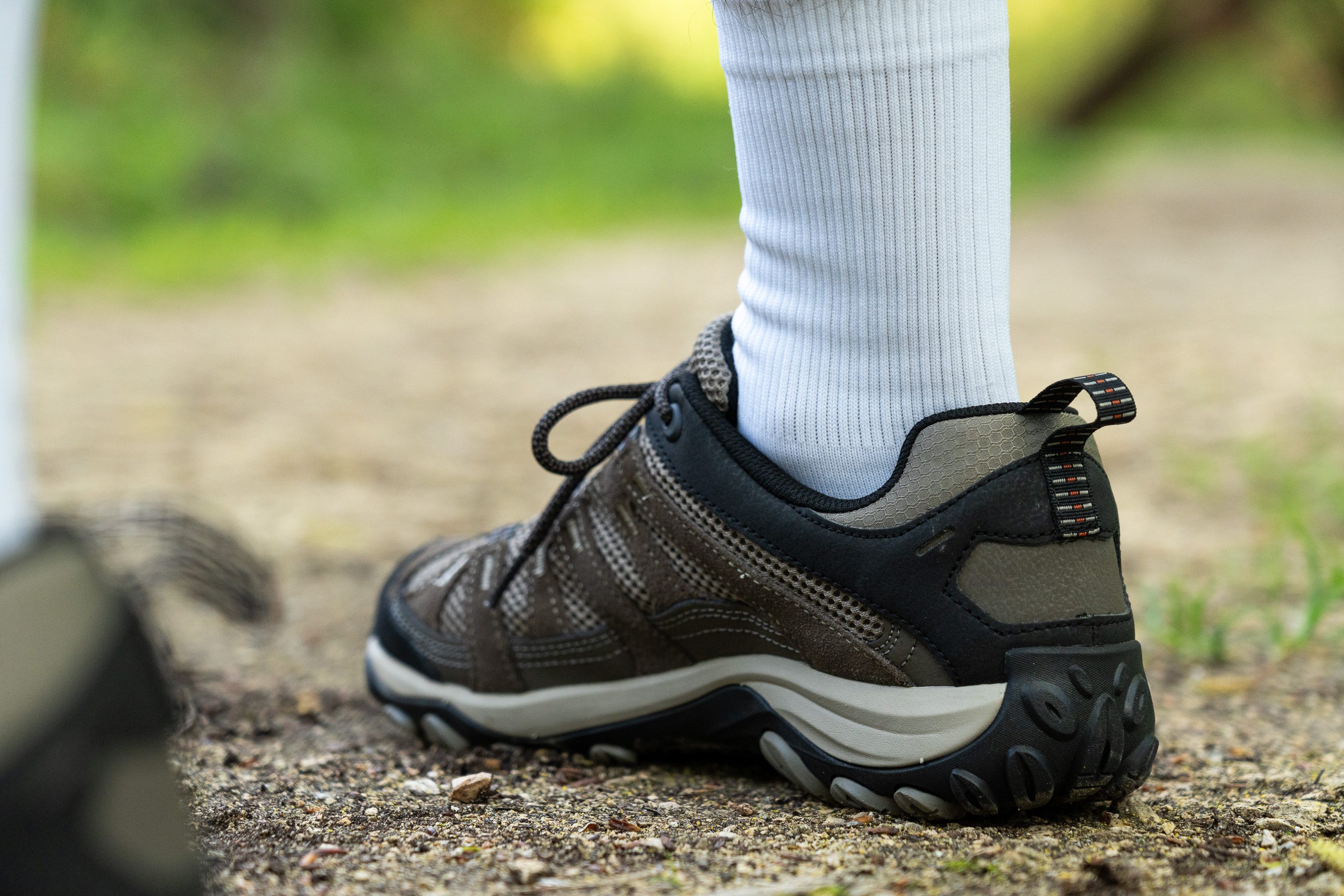
| Alverstone 2 | Finger loop |

